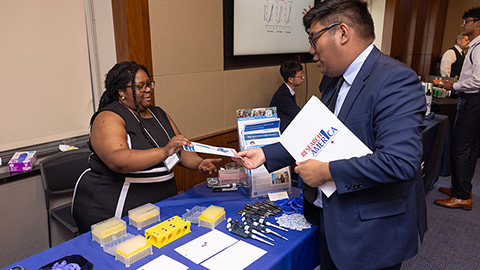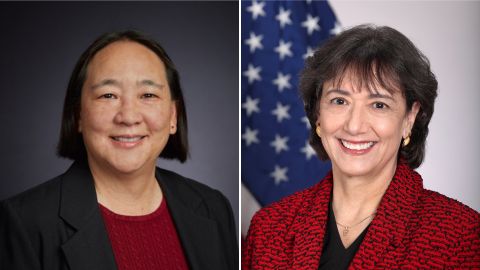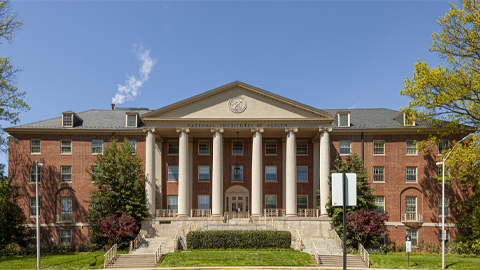Early-career scientists need pandemic relief funds
The COVID-19 pandemic has affected workers in every sector of the American economy. In the biomedical enterprise, early-career scientists, especially those from historically underrepresented backgrounds, have been hardest hit.
University campus closures have limited access to classrooms and labs, delaying degree and research project completion. Social distancing has made hands-on instruction and in-person collaboration impossible, slowing learning, innovation and problem-solving. Increased domestic and caregiving responsibilities have eaten up both time and mental bandwidth, especially for women.
These new challenges sit atop longstanding ones faced by early-career scientists, including limited research funding and intense job competition.
Federal science agencies are working to quantify the pandemic’s effects on the education and career prospects of graduate students, postdoctoral scholars and new investigators, but in the meantime those early-career scientists are desperate for help — and having to make difficult decisions.

“It was either you had to just come into the labs and risk your safety or just end up having to lose months and months of work,” said Dominique Baldwin, a third-year Ph.D. student at Indiana University. Baldwin continues to conduct research in his lab, but within the limitations of social-distancing measures in place.
Early-career scientists certainly need support from their institutions and colleagues. But more importantly, they need help from the federal government, which has the most to lose if they ultimately leave the science, technology, engineering and mathematics workforce. The federal government, after all, has invested taxpayer dollars, in the form of research grants, in their now-imperiled careers.
The American Society for Biochemistry and Molecular Biology is urging Congress to pass immediate, targeted COVID-19 relief for junior scientists. In a policy proposal released Feb. 9, the society recommended that Congress provide an additional year of funding for students and early-career researchers whose grants expired in 2020 before they could complete their training and/or research.
Several publications, such as a report in August by the Council of Governmental Relations and a white paper in January by the nonpartisan research organization NORC at the University of Chicago, have recommended that institutions extend deadlines for graduate students and postdocs by at least one full year after the pandemic ends, if not longer. Doing so would allow STEM students to complete high-quality research and would increase the likelihood that they’ll remain in STEM fields.
But many institutions simply do not have the money to support such extensions. Without federal support, vulnerable but valuable scientists are at risk of dropping out of the biomedical workforce — at a time when they are needed most.

Negative impact on science career trajectory
According to the National Institutes of Health’s COVID-19 impact survey, released in November, 65% of trainees believe the pandemic will have a negative impact on their careers.
They’re not wrong.
According to the National Science Foundation, significant career gaps, such as running out of federal grant funding or delaying the completion of graduate education, could result in a significant loss of STEM talent.
Prior to the pandemic, numerous studies showed that women and minorities are pushed out of STEM fields at nearly every career transition or milestone and that women who stop doing research find it especially difficult to re-enter the research enterprise.
The pandemic is exacerbating these existing challenges.
A study published in Nature Human Behavior in July found that women have been hit with a double whammy during COVID. “Female scientists and scientists with young dependents reported that their ability to devote time to their research has been substantially affected, and these effects appear additive: the impact is most pronounced for female scientists with young dependents,” the authors wrote.
The COVID-19 childcare crisis has resulted in women leaving the U.S. workforce at a rate four times higher than men.
Women of color, in particular, are bearing the brunt of this public health crisis. Health disparities, created and perpetuated by structural racism, put them at higher risk of experiencing severe COVID-19. Not only do they have higher rates of pre-existing conditions, but they also are more likely to live in multigenerational households that make social distancing and isolation difficult.
It is no surprise that they are experiencing more cases, hospitalizations and deaths and, on top of that, the biggest economic losses compared with other groups.
If these trends continue, the STEM workforce will be significantly less diverse, reversing the gains that all women, women of color specifically, and other underrepresented minorities have made in recent decades.
If Congress establishes pandemic relief funds specifically for junior women in STEM, more of them will complete their education or training and persist in the STEM workforce. ASBMB’s policy proposal strongly recommends a prioritization strategy that ensures that women of color and other minorities, specifically, get the funds they need.
Not enough time in the lab
Prior to the pandemic, scientists reported spending an average of 61 hours per week on planning experiments, collecting or analyzing data, fundraising, and other administrative or clinical duties.
New standards for research operations have redefined how scientists do their work for the past year. These include restricted access to laboratories, social distancing within labs, staggered shift-scheduling and additional time required to clean lab space and equipment.
Total working hours for scientists have decreased by 11% on average, and time devoted to research itself has declined by 24%, according the study in Nature Human Behavior.
By September, eight out of 10 postdoctoral researchers reported the pandemic had hampered their ability to conduct experiments or collect data, according to a survey of 7,670 postdocs by the journal Nature.
The graduate students ASBMB Today talked to also reported productivity declines.

“The pandemic has slowed down myself and others because labs are working in shifts,” said Joseph Magrino, a Ph.D. candidate studying macromolecular machines at the University of Massachusetts Medical School. “You have to socially distance in some capacity, and that has been a major hurdle.”
Others have been able to do at least some of their research from home.
Baldwin’s principal investigator at Indiana University runs the medical school’s proteomics core. “Because our lab is a big data-focused lab, one of the luxuries for us is that there’s a lot of research time spent on a computer analyzing data,” Baldwin said.
Productivity and dissemination affected
Junior scientists are having fewer interactions with their mentors and colleagues, which also reduces productivity.
It’s important for junior scientists, and especially women and underrepresented minorities, to work with mentors. But, as demands on everybody’s time have increased during the pandemic, maintaining mentee–mentor relationships has become more difficult.
“An increasing challenge is that (your) PI — they don’t need to come to campus,” Magrino said. “I see my mentor mostly virtually. He used to come in every day to check in on us. And now he has a million more tasks to do.”
As the pandemic extends well into 2021, established scientists are figuring out how to network with junior scientists and maintain relationships that might have eroded during the pandemic. Social media, in particular, has played a crucial role in connecting scientists with one another.
However, more than half of the respondents in the Nature survey over the summer said they were finding it harder to share their work with their lab heads or colleagues. And, according to the NIH impact survey, trainees were most likely to report being negatively impacted by being physically separated from colleagues.
That includes people in their own cohort. Student–student interactions facilitate learning while doing research, but social distancing requires staggered shifts in the lab.
Magrino said that, for first-year graduate students, working with others in your cohort is vital to understanding challenging research papers and to overcoming roadblocks in experiments.

Julia de Amorim, a Ph.D. candidate at Emory University, agreed: “I definitely relied heavily on my classmates — not just for actual understanding of the material, but, you know, moral support.”
Baldwin added: “A lot of what I’ve learned has been from other students in the lab. Now, there’s a lot of times, if something is going wrong, I have to wait for my weekly meeting (with my PI).” He said that has caused a significant delay in his research and added stress.
Finally, graduate students and postdoctoral fellows have missed out on in-person scientific conferences at which they present their work, network with lab heads and hiring managers, and exchange ideas.
“An integral part of science is sharing science, and we did that through live talks with speakers or conferences. Now that everything is virtual, it is so hard,” de Amorim said.
Grant extensions would make a real difference by giving junior scientists more time with their currently overextended PIs and members of their cohort.
If federal agencies provide grant extensions, junior scientists will have more time to work with their PIs, more time to spend collaborating and troubleshooting with members of their cohort, and more time disseminating their research and networking.
Role of federal agencies
After the U.S. Department of Health and Human Services declared a public health emergency for COVID-19 in January 2020, the NIH extended short-term administrative flexibilities to NIH applicants and recipients. Other federal funding agencies, such as the NSF and the Department of Energy, instituted similar administrative flexibilities, but few policy changes have addressed the unique challenges that junior scientists are facing.
In early February, the NIH issued a notice allowing recipients of fellowship (“F”) and career-development (“K”) awards to request extensions. But those extensions will be granted only “within the existing constraints of available funding.”
Aside from processing daily grant payments, extending deadlines for submitting proposals, and continuing to provide stipend payments to fellows and trainees who may be unable to work as a result of COVID-19, federal agencies have few other options to support junior scientists.
As the NIH struggles to sustain funding and funding extensions for its scientists while prioritizing COVID-19 research, other fields of research are suffering.
Magrino said he is concerned about the future of funding for junior scientists who do fundamental research: “I worry that we’re going to lose funding or opportunities for funding for things ... that don’t have an immediate translational attribute. The basic sciences are not well-funded anymore, from a graduate school perspective.”

Terri Goss Kinzy, vice president for research and innovation at Western Michigan University and chair of ASBMB’s Public Affairs Advisory Committee, said that continuing to support basic research and the STEM workforce that conducts basic research is more important than ever.
“The COVID-19 pandemic has demonstrated the power of basic research on mRNA to drive the development of a new approach to vaccines,” she said. “While we all worry about deficits and possible future spending cuts, we can all do our part to remind Congress of the importance of basic research in solving the nation’s problems.”
Congress should act
Federal lawmakers recognize that the scientific community needs support.
Two bills introduced in Congress would help mitigate the impact of COVID-19 on the research community: the Research Investment to Spark the Economy Act, or the RISE Act, and the Supporting Early-Career Researchers Act. But neither of these bills focuses on supporting the most vulnerable groups within the scientific community.
Re-introduced in the 117th Congress, the RISE Act, if passed, would authorize nearly $25 billion to support U.S. researchers whose non–coronavirus-related research has been affected by the pandemic. More than 300 organizations have endorsed the RISE Act, but it continues to stall in Congress as lawmakers grapple with the next COVID-19 relief package.
The Supporting Early-Career Researchers Act would authorize the NSF to establish a two-year pilot program to award grants to early-career investigators to carry out independent research programs at their institutions. While this would support future junior scientists, it would not address the impacts of the pandemic on current ones.
If junior scientists don’t get the support that they desperately need, the American research enterprise is at risk of losing a vital component of the STEM workforce. This is why the ASBMB is calling for targeted COVID-19 relief for STEM graduate students, postdoctoral fellows and others in similar positions.

“Taxpayers invested in the training of the next generation of American scientists,” said Benjamin Corb, ASBMB’s public affairs director. “For those junior scientists who were close to completion and were hurt by the pandemic — we owe it to them and to the enterprise to help see them through these hard times.”
While supplemental funding will not solve all the challenges junior scientists are facing as a result of the pandemic, an additional year of funding would help retain talent when the American research enterprise badly needs it.
Enjoy reading ASBMB Today?
Become a member to receive the print edition four times a year and the digital edition monthly.
Learn moreFeatured jobs
from the ASBMB career center
Get the latest from ASBMB Today
Enter your email address, and we’ll send you a weekly email with recent articles, interviews and more.
Latest in Policy
Policy highlights or most popular articles

Summer internships in an unpredictable funding environment
With the National Institutes of Health and other institutions canceling summer programs, many students are left scrambling for alternatives. If your program has been canceled or delayed, consider applying for other opportunities or taking a course.

Black excellence in biotech: Shaping the future of an industry
This Black History Month, we highlight the impact of DEI initiatives, trailblazing scientists and industry leaders working to create a more inclusive and scientific community. Discover how you can be part of the movement.

ASBMB releases statement on sustaining U.S. scientific leadership
The society encourages the executive and legislative branches of the U.S. government to continue their support of the nation’s leadership in science.

ASBMB and advocacy: What we accomplished in 2024
PAAC members met with policymakers to advocate for basic scientific research, connected some fellow members with funding opportunities and trained others to advocate for science.

‘Our work is about science transforming people’s lives’
Ann West, chair of the ASBMB Public Affairs Advisory Committee, sits down Monica Bertagnolli, director of the National Institutes of Health.

Applied research won’t flourish without basic science
Three senior figures at the US National Institutes of Health explain why the agency remains committed to supporting basic science and research.

